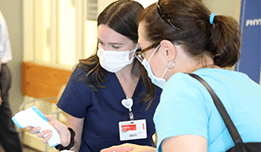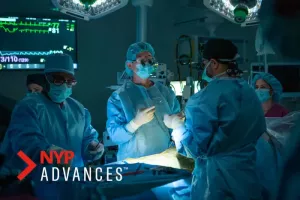Having a comprehensive care team benefits both children and adults living with cystic fibrosis (CF). At NewYork-Presbyterian and Columbia, patients with CF have access to the expertise of pulmonologists, infectious disease specialists, dietitians, social workers, gastroenterologists, otolaryngologists, pharmacists, and physical therapists. But most notably, for parents of newborns who just received a CF diagnosis, they have access to a genetic counselor.
Hossein Sadeghi, M.D., a pediatric pulmonologist and director of the Sue & John L. Weinberg Cystic Fibrosis Center at NewYork-Presbyterian and Columbia, researches the ways in which health disparities affect his patients with CF. Recently, Dr. Sadeghi assessed the value of having access to a certified genetic counselor for parents of infants with complex cystic fibrosis transmembrane conductance regulator (CFTR) genotypes conferring uncertain phenotypes. The results from this study were published in Pediatric Pulmonology.
Below, Dr. Sadeghi discusses the important role a genetic counselor plays in the care of patients with CF, the learnings from this recent quality improvement initiative, and the need for more centers across the country to adopt a comprehensive care model that includes a consultation with a certified genetic counselor.
Access to Genetic Counselors Varies in New York State
In New York State, all infants are screened at birth for cystic fibrosis using the cystic fibrosis newborn screening (CFNBS) CFTR gene sequencing. This is one of the best newborn screening programs in the country. When an infant tests positive for having >1 CFTR variant of potential clinical relevance, they are referred to a New York State CF Specialty Care Center (SCC), like NewYork-Presbyterian and Columbia.
It’s important to note that a positive newborn screen is not a diagnostic test. Of those who are CFNBS positive, many end up not receiving a CF diagnosis and instead may have CFTR-related metabolic syndrome/CF screen positive, inconclusive diagnosis (CRMS/CFSPID) or are CF carriers. Regardless of their diagnosis, it’s critically important that these individuals have access to a genetic counselor to address the implications of the CFNBS results and obtain the additional testing needed.
Unfortunately, genetic counseling is not available at all centers. So as part of a quality improvement initiative, we sought to understand how many families of infants with a positive CFNBS go on to receive CFTR phasing and counseling from a certified genetic counselor.
Our analysis focused on 289 infants who were CFNBS-positive, but did not meet the diagnostic criteria for CF. Of those, 16.5% (32) were classified as CF carriers, and the remaining had CRMS/CFSPID.
Of the 289 infants in the study, 263 were evaluated at a New York State SCC for CF. While 70.3% of families indicated that they received genetic counseling about their infant’s CFNBS results from any provider at the specialty care center, only 36.5% were counseled by a certified genetic counselor, indicating a need to improve access to trained geneticists.
How Families Benefit from Genetic Counseling
At NewYork-Presbyterian and Columbia, we have a genetic counselor who specifically works with our CF program. While physicians can and do have conversations with families about the genetics of CF, a certified geneticist can go into full detail and answer any questions they may have.
Meeting with a genetic counselor helps families make informed decisions about future pregnancies. Genetic counselors provide guidance on the chances that offspring will have CF, be a carrier for the disease, or have CRMS/CFSPID.
Unfortunately, not every CF center in New York State has access to a certified genetic counselor. To help increase access, NewYork-Presbyterian and Columbia recently received a grant that will hopefully create opportunities for our genetic counselor to train others across the state.
Every patient who comes to our center becomes part of the family. As I say to them on their first visit, this is a family they did not want to have, but they have become a part of it.
— Dr. Hossein Sadeghi
The Cystic Fibrosis Center at NewYork-Presbyterian and Columbia
When a new patient with a positive CFNBS result comes to our center at NewYork-Presbyterian and Columbia, we begin our intake process by making phone calls to the patient’s family and pediatrician. Sometimes the diagnosis comes as a surprise to the parents; sometimes the family is already aware if they did prenatal or pregnancy genetic testing with their obstetrician. We then schedule a time for the family to bring in their infant for a sweat test and to meet with our genetic counselor.
From there, we go educate the families on a variety of topics related to CF in infants, such as knowing how to add enzymes and vitamins to their baby’s milk or formula to address malabsorption. At three to four months of age, we introduce airway clearance, teaching the traditional ways of airway clearance as well as alternative techniques. We follow our patients regularly through their childhood, connecting them with specialists to address their needs as they grow. Patients begin our comprehensive transition program with the Gunnar Esiason Adult Cystic Fibrosis and Lung Program at NewYork-Presbyterian and Columbia around the age of 10, which prepares them to make a smooth transfer from pediatric to adult care at the age of 18 to 23 years of age.
In addition to comprehensive care, we have a long history of with CF at our institution: Dr. Dorothy H. Andersen differentiated CF from celiac disease, and Dr. Paul di Sant’Agnese discovered elevated chloride ion concentration in patients with CF, which led to the sweat testing that to this day is the gold standard for diagnosing CF. We direct and participate in a range of clinical studies to evaluate new therapies for CF and ensure that our patients know about and are offered the opportunity to participate in these trials.
Every patient who comes to our center becomes part of our family. As I say to them on their first visit, this is a family they did not want to have, but they have become a part of it. We laugh together, and we cry together.




